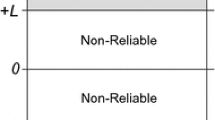Abstract
Convolutional tailbiting codes are widely used in mobile systems to perform error-correcting strategies of data and control information. Unlike zero tail codes, tailbiting codes do not reset the encoder memory at the end of each data block, improving the code efficiency for short block lengths. The objective of this work is to propose a low-complexity maximum likelihood decoding algorithm for convolutional tailbiting codes based on the Viterbi algorithm. The performance of the proposed solution is compared to that of another maximum likelihood decoding strategy which is based on the A* algorithm. The computational load and the memory requirements of both algorithms are also analysed in order to perform a fair comparison between them. Numerical results considering realistic transmission conditions show the lower memory requirements of the proposed solution, which makes its implementation more suitable for devices with limited resources.




Similar content being viewed by others
References
ETSI (2013) 3GPP TS 36.212 v. 11.3.0. LTE evolved universal terrestrial radio access (E-UTRA): multiplexing and channel coding. ETSI, Sophia Antipolis Cedex
IEEE (2009) IEEE 802.16-2009. Air interface for fixed and mobile broadband wireless access system. IEEE, New York
Ma HH, Wolf JK (1986) On tail biting convolutional codes. IEEE Trans Commun 34(2):104–111
Cox RV, Sundberg CW (1994) An efficient adaptative circular Viterbi algorithm for decoding generalized tailbiting convolutional codes. IEEE Trans Veh Tech 43(2):57–68
Shao RY, Lin S, Fossorier MPC (2003) Two decoding algorithms for tailbiting codes. IEEE Trans Commun 51(10):1658– 1665
Anderson JB, Hladik SM (2002) An optimal circular Viterbi decoder for the bounded distance criterion. IEEE J Sel Areas Commun 50(11):1736–1742
Ortin et al (2009) Two step SOVA-based decoding algorithm for tailbiting codes. IEEE Commun Lett 13(7):510– 512
Hagenauer J, Hoeher P (1989) A Viterbi algorithm with soft-decision outputs and its applications. In: Proceedings of the IEEE GLOBECOM, Dallas
Pai H-T, et al (2008) Low-complexity ML decoding for convolutional tail-biting codes. IEEE Commun Lett 12(12):883–885
Ortin J, et al (2010) A low complexity maximum likelihood decoder for tailbiting trellis. IEEE Commun Lett 14(9):854– 856
Wang X, et al (2013) An efficient ML decoder for tail-biting codes based on circular trap detection. IEEE Trans Commun 16(4):1212–1221
Souza RD, Pimentel C, Muniz DN (2012) Reduced complexity decoding of convolutional codes based on the M-algorithm and the minimal trellis. Ann Telecommun 67:537–545
Acknowledgments
This work has been financed by the Spanish Government (Project TEC2011-29126-C03-03/TEC from MICINN and FEDER) and DGA-FSE.
Author information
Authors and Affiliations
Corresponding author
Rights and permissions
About this article
Cite this article
Ortín, J., Dúcar, P.G., Gutiérrez, F. et al. An efficiently implementable maximum likelihood decoding algorithm for tailbiting codes. Ann. Telecommun. 69, 529–537 (2014). https://doi.org/10.1007/s12243-013-0400-9
Received:
Accepted:
Published:
Issue Date:
DOI: https://doi.org/10.1007/s12243-013-0400-9




